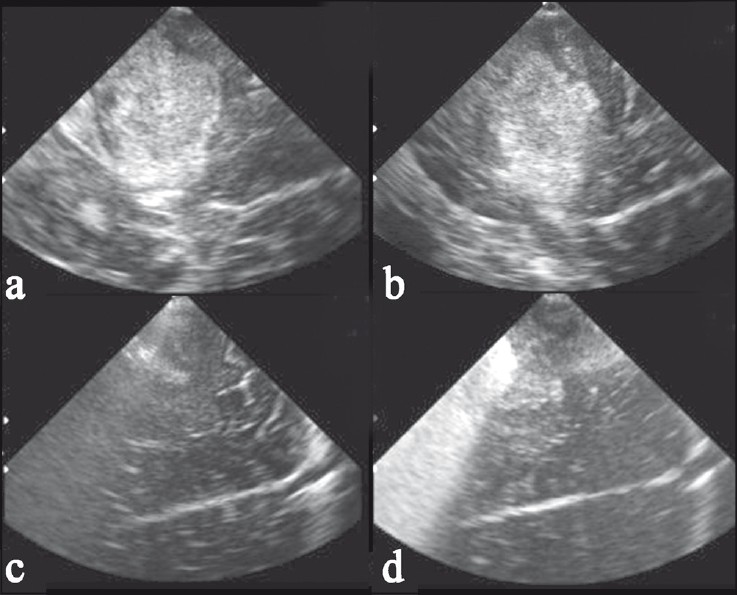Translate this page into:
Real-time intraoperative ultrasonography in the surgical resection of brain lesions: A cheap, effective, and quick alternative
Address for correspondence: Dr. PK Upadhyay, Type VI/5, Institute of Human Behavior and Sciences Campus, Dilshad Garden, Delhi – 110 095, India. E-mail: upadhyaypk5@yahoo.co.in
This is an open-access article distributed under the terms of the Creative Commons Attribution-Noncommercial-Share Alike 3.0 Unported, which permits unrestricted use, distribution, and reproduction in any medium, provided the original work is properly cited.
This article was originally published by Medknow Publications and was migrated to Scientific Scholar after the change of Publisher.
Sir,
Neuronavigational systems are becoming more and more available in neurosurgical operation theaters and have become a standard form of accessories in the operating room for surgical resection of brain and spinal cord lesions.[1] Many intraoperative guiding systems have been developed, including intraoperative magnetic resonance imaging (MRI; Brain suit) for this purpose,[23] however, these instruments are quite expensive. Therefore, the need for intraoperative real-time imaging has becomes more important, although it may not be that efficient but it can partially overcome the problem of the cost. Apart from this it is cheap, portable, and accurate and may be more useful while working with limited resources.[1] Five consecutive brain tumor cases in supratentorial region as well as in infratentorial region were operated and a real-time neuronavigation system was used by senior author in the near past [Figure 1]. Multiple images were taken at the start of operations, during the procedures, and at the end of the procedure. At the end, the extent of tumor excision was assessed and if there was any tumor left, further excision was performed keeping in mind “safe resection.” Postoperative CT or MRI images were performed and compared with the extent shown in intraoperative ultrasonography (USG) to correlate the extent of tumor excision and reliability vis-a-vis CT or MRI imaging. It was found that the real-time intraoperative USG helped us to guide the extent of tumor and extent of excision or decompression of the tumors and correlated quite well as inferred with the postoperative CT or MRI imaging.

- Intraoperative pre-excision images (a and b), intraoperative postexcision images (c and d)
The intraoperative USG images may be as good as if not superior to good quality MRI images.[45] The intraoperative USG imaging may easily be performed through the same opening as used for resection of tumor.[1] Most neurosurgeons are familiar with the MRI images than the USG because they interpret MRI images every day in clinical practice, but Neurosurgeons who have started using USG and want to explore the possibilities need to learn the new technique very quickly.[1] Many groups have reported the clinical efficacy of using USG to get intraoperative updates for surgical guidance and control.[6–8] USG-guided micro-neurosurgery represents a handy, reliable, and relatively low-risk procedure for the treatment of intra-axial brain tumors.[9] Intraoperative real-time USG can be very useful and cost-effective portable alternative as against very costly and cumbersome alternatives; however, we need to study further to assess the feasibility of this procedure.
References
- Intra-operative 3D ultrasound in neurosurgery. Acta Neurochir (Wien). 2006;148:235-53.
- [Google Scholar]
- Intra-operative magnetic resonance imaging in neurosurgery. Acta Neurochir (Wien). 2004;146:543-56.
- [Google Scholar]
- Intraoperative high-field-strength MR imaging: Implementation and experience in 200 patients. Radiology. 2004;233:67-78.
- [Google Scholar]
- Intraoperative uses of ultrasound in the pediatric neurosurgical patient. Pediatr Neurosurg. 1992;18:84-91.
- [Google Scholar]
- Initial experience with an ultrasound-integrated single-RACK neuronavigation system. Acta Neurochir (Wien). 2001;143:1127-32.
- [Google Scholar]
- Intraoperative US in interactive image-guided neurosurgery. Radiographics. 1998;18:1019-27.
- [Google Scholar]
- History of intraoperative ultrasound in neurosurgery. Neurosurg Clin N Am. 2001;12:155-66.
- [Google Scholar]
- Intraoperative sonography of intracranial arteriovenous malformations: How we do it. J Ultrasound Med. 2004;23:1065-72.
- [Google Scholar]
- Intraoperative real-time ultrasonography in the microsurgical removal of subcortical or deep-seated brain tumors. Acta Chir Belg. 1993;93:185-7.
- [Google Scholar]





